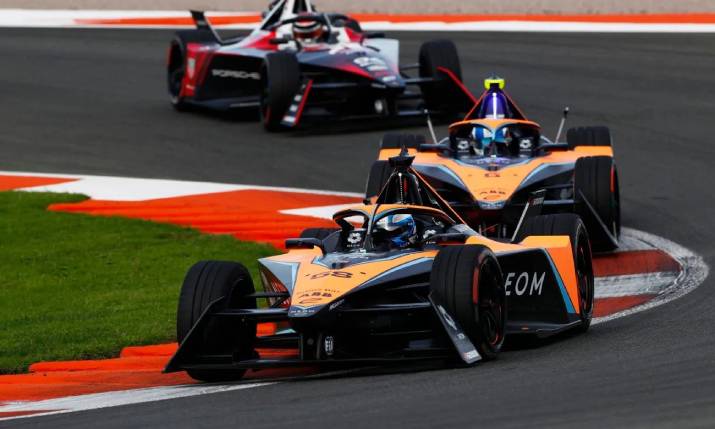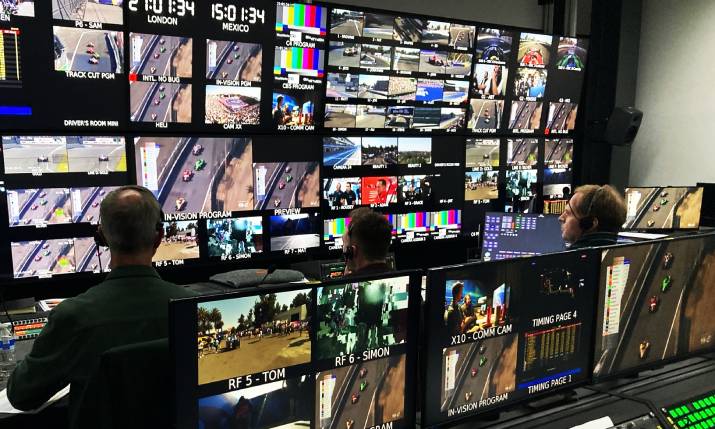Feeding curiosity: Formula E on using data and onboard cameras to bring new levels of information to existing and potential motorsport fans

Formula E built a brand new onboard camera system for its GEN3 cars that was introduced this season by Richard Baker, senior broadcast technology manager at Formula E, aided by Timeline TV
The ABB FIA Formula E World Championship is introducing more data into the TV presentation of races to give its global audience and increasingly more curious fanbase a deeper immersion into what it means to be part of this racing series.
One surprising fact for Formula E rookies is that the GEN3 race car used by all teams in the series – the fastest, lightest, most powerful and efficient electric race car ever built – starts each race with only 60% to 65% of the battery power it needs to complete the race.
Unlike any other motorsport using internal combustion engines where a refuelling pitstop is required to fill up, a Formula E driver does not need to stop during the race. Instead, they must race intelligently and aggressively to balance speed – which depletes the car battery – with a more strategic race with precision-timed overtakes – which allow the car to regenerate power – in order to pass the finish line.
Brand new onboard camera system
Data from the car, and the addition of new onboard cameras developed for Formula E by Timeline TV, is about to help bring the story of each race, each car and each driver to life with new insight.
Formula E built a brand new onboard camera system for its GEN3 cars that was introduced this season by Richard Baker, senior broadcast technology manager at Formula E, aided by Timeline TV. The system incorporates nine off-the-shelf onboard mini cameras, with up to two sending content back to Formula E’s crew live during the broadcast, while the others continue to record onboard for storytelling use.
Check out some of the angles from the new onboard cameras here:
Comments Baker: “When the cars come back, crew pull memory chips from each car and then we ingest 45 minutes times eight cameras times 22 cars-worth of footage straight into AWS, which gives our editors – with an event log of what overtakes happened at what time – a tremendous amount of catalogue to build anything out of it.”
Adds Baker: “A lot of the motorsports people and federations have seen [the new onboard cameras]. They say it’s one of the best things they’ve seen so far, which is kind of a nice tribute to the work that was done there. The front camera is not off-centred like in Formula 1; it’s nice and centred. The sensor on top – the t-piece on the very top – that’s the same quality as the sensor and the track camera on the side of the track, so the image is really sharp, really nice. There’s also a camera underneath the car showing the suspension, because [Formula E cars are] not that close to the ground, so we can do that.”
Baker says the reason not all the onboard cameras are available for the live broadcast all of the time is down to the places in which Formula E races are held; unlike on an open track where the frequency ranges are more flexible, there are significant transmission challenges posed by a city set up full of buildings and concrete.

Data from Formula E cars, and also with the addition of new onboard cameras developed for Formula E by Timeline TV, is about to help bring the story of each race, each car and each driver to life with new insight. Pictured here, Gravity Media’s Westworks production centre in London
Interpretation of new data
The new onboard camera angles are soon to be complemented with the addition of the interpretation of new data to give fans at home insight into this unique race. With aspects such as the need to renew battery power during the race, the car’s performance and driver’s decisions provide a lot of additional content that can open up new angles to the story of each race.
The race series is about to implement some of this data after a period of trial and error, notes Ernst: “It’s a very short race that we have and there’s a lot of stuff happening. We don’t want to overwhelm viewers. We have different technologies which we’ve tested and now shelved, and we’re just about to maybe spin up, hopefully soon, aspects that work so we can do graphics pointers and show different things.”
As to whether this data will be shown on the main broadcast or elsewhere, Ernst says: “I think it’s more going to go into a second screen experience and not an over the top (OTT) one; more of a data experience where we can add some commentary or those numbers in a natural language way where a chatbot will be telling you what’s happening, or in a graphical way.
“One of the biggest issues is that you don’t want to do any spoilers, and data is a lot faster than video; obviously we want people to be focused on the broadcast and not the second screen, because that’s where the value comes from.”
He continues: “Other championships take the second screen like timing and then make a TV signal out of it and send that so it’s aligned with what you watch on TV. But that doesn’t make sense for me; it’s a hundred times the traffic you’re sending. There’s other ways of doing it and we’re looking at different things. It’s actually really, really hard to make it a good experience worldwide.”
Bringing in new fans
Adds Ernst on the areas of data that the championship intends to provide to viewers: “There’s a tremendous amount of other numbers that we’re bringing in. The amount of overtakes, which is very high due to the racing format that we have, with the attack mode that creates spectacular racing. These cars can be very quick, so we know we’re starting to get very close to other classes in terms of performance, even though we don’t have the downforce that a car would have with proper aerodynamics; street racing is all about suspension rather than aerodynamics. That’s starting to get really interesting.”
“We’re really beginning to show how we’re starting to get into that area where everybody thinks it’s super high performance, and we’re starting with numbers, trying to show what are the g-forces on the car and the driver,” he continues. “An average g-force on a driver in Formula E is 0.9g acceleration any direction. Formula One is around 1.6g. So we’re getting close there.”
This comparison with F1 is about attracting new fans, explains Ernst: “Do we want to catch up with Formula One? Do we want to be Formula One? No, we don’t,” he states. “But we need to align with all those motorsports fans that don’t know us yet, so they can start pulling comparisons, then they can decide if they like [Formula E] or not. Data helps us there to massively start putting in that narrative, either on a second screen or within the broadcast, to help commentators spot things that are happening that we don’t see on broadcast.”
Ernst looks ahead to how Formula E will progress over coming years: “Everything is always going to be about that 45 minute race, but how it’s going to be viewed and who’s going to view it, when they’re going to view it, and on what format, device; that probably is going to massively change over the next five years in motorsports.
“Now we know that we can adapt to that really, really quickly. I think that’s the key thing. And splice it together with data, which is now flowing right next to the imagery, because the data is going to be directing the look.
In conclusion, Ernst says: “So we had a lot on last year. We built a brand new broadcast technical facility system and a brand new onboard camera system. We’ve changed the game for how live sports is produced, continuing in Formula E’s leadership mission for improving sustainability in elite sports.”

